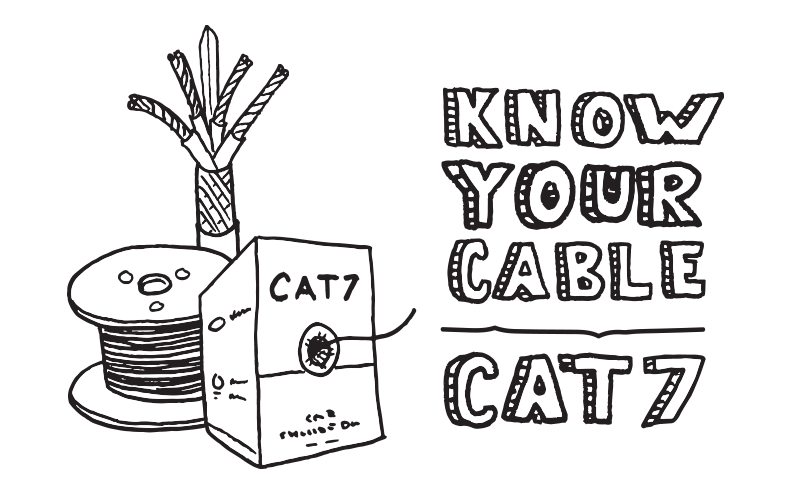Payment methods accepted

Cat7 Ethernet Cable: What You Need to Know
Written by Don Schultz, trueCABLE Senior Technical Advisor, Fluke Networks Copper/Fiber CCTT, BICSI INST1, INSTC, INSTF Certified
No doubt while shopping for Ethernet cable you have seen Cat7 cabling for sale. What exactly is this type of cable and should you use it? Let’s see if we can let the “Cat” out of the proverbial bag!
The Cat you don’t need or even want...
Every so often you will see a product that promises everything and more. It is marketed as a way to increase your speed, overcome all interference, and what you should buy for the future. Sadly, this is how Cat7 is positioned to take advantage of the uninformed. The number is higher, so it must be better right? Not necessarily. The truth of the matter is Cat7 is not even ANSI/TIA recognized in North America. Cat7 is defined by an international specification created by ISO/IEC.
Here are the ANSI/TIA 568 2.D recognized cable Categories and what they can do:

So, that covers the North American ANSI/TIA side. How does Cat7 compare? Cat7 is defined by ISO/IEC 11801.

Taking a look at the specifications between Cat7 and Cat6A we have identical performance for all intents and purposes, regardless of the specification difference of 100 MHz, which means they will both run at the maximum 10 Gigabit speed. There is no reason to opt for Cat7 when bulk Cat6A cable is readily found and typically for less money. Cat6A will also be far easier to work with and terminate.
Reality sets in….
Unless your network equipment is up to the task, you are likely using 1 Gigabit Ethernet technology like 99% of the world. 10 Gigabit equipment is extremely expensive. While it is becoming more available, it is likely only found in medium and large businesses that have the need for very high speed. Cat7 cable will not make your existing network equipment or internet any faster. You will simply waste money. For the average home and small business user, purchasing anything higher than Cat6 is of no benefit either. This all said, if your network is designed to run 10 Gigabit speed, and you need this speed past 110 feet (165 feet depending on conditions) then indeed Cat6A is the way to go. For help with deciding what network technology best matches the cable to use, take a look at The Need for Speed.
NBASE-T is also a game changer. Now, 2.5GBASE-T and 5GBASE-T are realities for existing Cat5e and Cat6 (respectively) unshielded cable installations. These speeds will satisfy all but the most demanding home and small business users. See more about NBASE-T in Just What is NBASE-T?
A note on both Cat7 and Cat8
Cat7 and Cat8 cable are fully shielded, and referred to as S/FTP. What this means is that not only does it have an overall braided shield, but also each individual pair is foil shielded as well. This makes for extremely stiff and thick cable, which will be difficult to terminate. Most installers will wish to terminate either of these Categories to patch panels or keystone jacks.
The long and short of it...
The best Ethernet cable for your network depends upon what your current equipment can support, while keeping a reasonable eye on the future. Network technology progresses, but not so quickly that a cabling installation will become obsolete overnight.
As always, HAPPY NETWORKING!
trueCABLE presents the information on our website, including the “Cable Academy” blog and live chat support, as a service to our customers and other visitors to our website subject to our website terms and conditions. While the information on this website is about data networking and electrical issues, it is not professional advice and any reliance on such material is at your own risk.



















![Fiber Optics vs Ethernet: Understanding the Key Differences [2024]](http://www.truecable.com/cdn/shop/articles/fiber_optics_vs_ethernet_blog_header_medium.jpg?v=1718740186)














